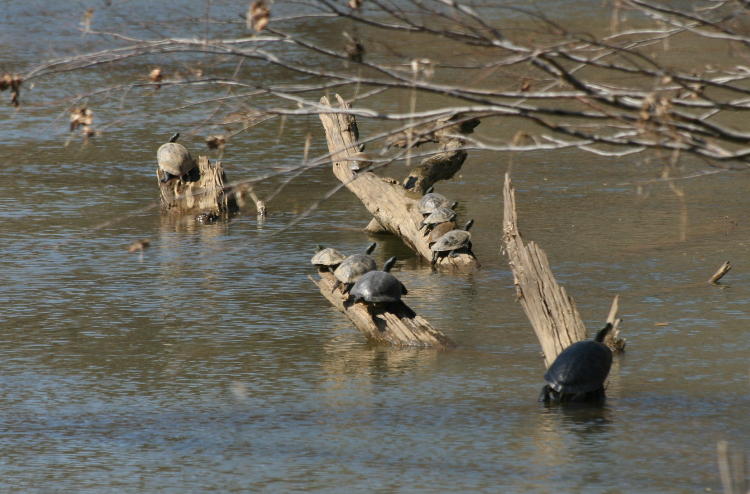
The past few weeks, the weather has been wildly variable – still with more rain than normal, but with temperatures and conditions fluctuating almost daily and just about the only dependable bit being, when it was nice, I was busy with non-nature-photography things and unable to take advantage of it. This changed a little on Tuesday, when I actually got out for a little hike, but did not find what I was looking for (more on that in a later post) and only shot a couple of unimpressive frames. On Thursday, however – it’s still Thursday as I type this bit, but it likely won’t post until after midnight – the Prompt and Dependable Mr Bugg and I did an outing which produced more than expected, especially given that it’s been dropping down close to freezing overnight. We weren’t at all sure what might be found, but I was fairly certain that we’d see some turtles, with a slim possibility, given that the temperatures were to hit 23°c or so, that a snake might make an appearance. As you can see above, the turtles did not disappoint, and could be spotted in abundance. They were quite wary, though, and tended to bail their basking spots for deep water at the slightest approach.
Within minutes, naturally, I spotted a small eastern garter snake (Thamnophis sirtalis,) which made me think a little. We were at one of the parks on the Eno River, which is the almost the only place in North Carolina that I’ve seen garter snakes, something that I find curious. Back in central New York, they were by far the most common snake around, and we had oodles in the yard, and I had up to a few dozen in a terrarium at once (mostly due to a pregnant female dropping a brood overnight one time – before that it was only 13.) Regardless, it was an auspicious start, but I have no photos because I was holding the specimen while Mr Bugg took some shots, so perhaps you’ll see them over on his blog.
The session was only a few hours long, and we could barely call this ‘spring’ despite the daytime temperatures – there’s still a chance some cold weather will blow through like last year – but you wouldn’t know it from the herpetological activity. A little later on, I happened upon a northern water snake (Nerodia sipedon sipedon) basking on a tree root alongside the water, which is very typical behavior.
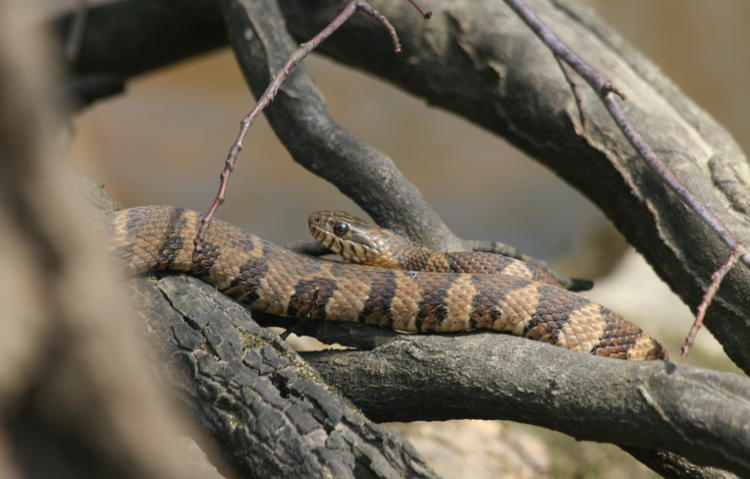
This one was quite alert, and upon first seeing it I backed out of sight to change lenses, then took a few longer shots. As I stepped cautiously closer while whistling for Mr Bugg to come over, it started sliding prudently from its perch, ready to slip into the water. It paused long enough to allow us both to get a few shots, but vanished entirely as I slipped around the other side of the tree to try and get a shot from directly above. As water snakes go, this one was medium-sized, perhaps a little bigger around than my thumb. The Eno River is a favorite haunt of the species, but the last time we were there they seemed to be scarce.
As it was, we spotted seven different snakes all told, of (at least) three different species; there was a chance one of them was a banded water snake (Nerodia fasciata) because they’re nearly identical and require a halfway-decent view of the markings to tell apart, which we didn’t get for one of them. And of course, the other very common water snake in the region is the queen snake, not too different from a garter snake and not at all fierce looking.
A bit later in the session, we heard the calls of some chorus frogs up in the forested areas bordering the river. The first time they seemed a little too distant to try and pursue, especially since we had more areas that we wanted to explore, but the second time the calls were closer and we were approaching the end of the session, so I figured it was a nice opportunity to seek them out. I knew they’d be in some shallow pool or pond area and would cease calling on our approach, but it was a bright sunny day and we stood a chance of seeing the diminutive amphibians if we looked close, or if we spooked them from the water’s edge (which is many times more likely, really.) It turned out that not only were they closer than I suspected, they were easier to find as well.

First off, I liked the little starburst on its shoulder, so much that this image is named “Brigadier.jpg” (a one-star general is also known as a brigadier general – I’m too clever for my own good.) However, I have to admit that I do not know what species this is, even after more than a little research. The markings do not match any photos nor descriptions that I’ve found, and while I’d like to consider this a juvenile and not in possession of adult markings yet, it’s really not the time of the year to find such things either – too early for this year’s hatchings, and last year’s should have been fully adult before they hibernated in the mud for the winter. So, if you know what this is, shout it out, don’t be shy.
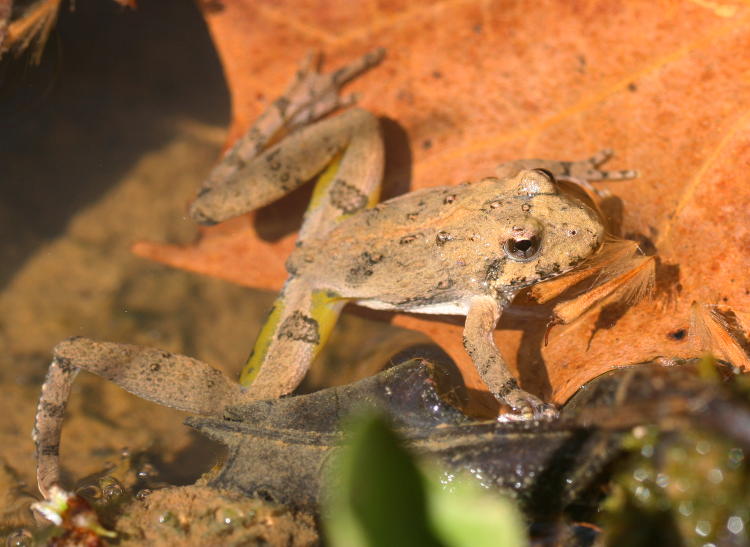
It goes without saying that all calls had ceased long before we even got close, so no help there. I’d say 20-25mm in body length.
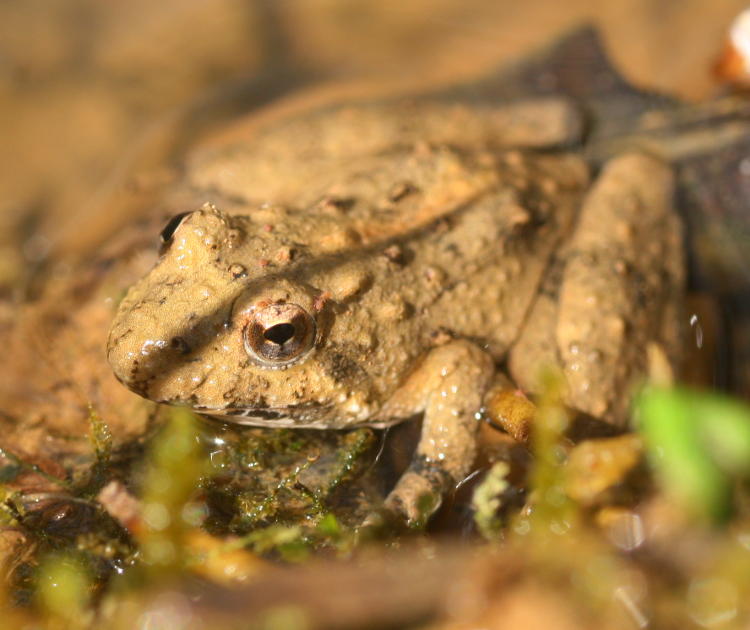
This one was remarkably cooperative, really. After first attracting my attention by jumping into the water (first shot,) it stayed put in clear view and bright sunlight even as I switched to the other side of the little basin it was in, and then swam to the edge and clambered out right in front of me. Even more astounding, it accepted a gentle nudge from me when that twig shadow was falling right across its eye, shifting to a slightly better position. I think it actually knew that I’d go crazy trying to determine its species, and so impishly posed so cooperatively to let me think I was being lucky, knowing the payback would come hours later. That’s playing the long game, that is.
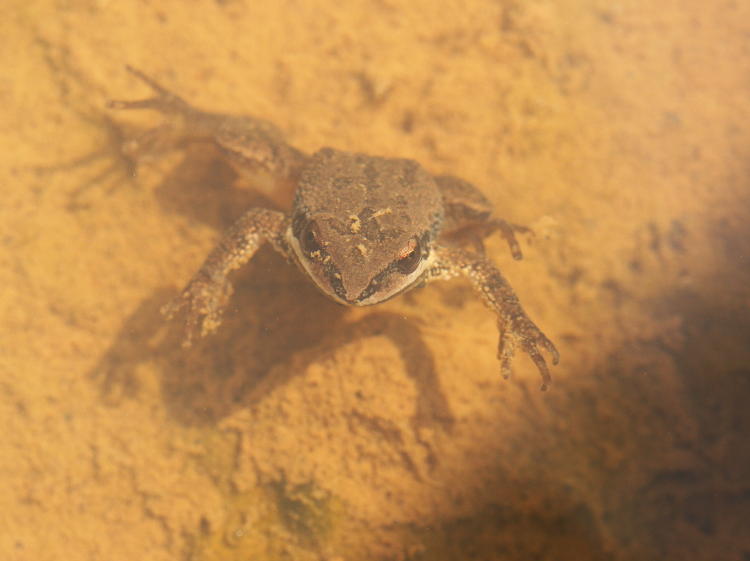
Mr Bugg supposedly got photos of me taking this shot and promised to send them to me as soon as he got home, but hasn’t yet done this even though I gave him two reminders, so… yeah. This is either an upland chorus frog (Pseudacris feriarum) or a southern chorus frog (Pseudacris nigrita) – their ranges overlap in this region and no guide that I have found gives any help in distinguishing the two, save the calls which, again, weren’t. I saw this one just floating upright under the surface… can it be floating if it’s submerged? It obviously wasn’t supporting itself on the bottom. Anyway, it stayed put, again quite cooperatively, while I stretched out on a limb that crossed the little pool and aimed straight down from above, only centimeters from the water’s surface, one of the odd things that macro photographers do even though I can’t show it to you because Mr Bugg. After my shots, I slipped a hand into the water and gently nudged it and it swam a short distance away, proving that it just wasn’t afraid of me enough to disturb its meditation.
Another of the same species (maybe) swam to the edge of the pool right beneath me and paused there, almost hidden, and when I tried to gently nudge it out into the open it instead crawled onto my hand. Okay then.
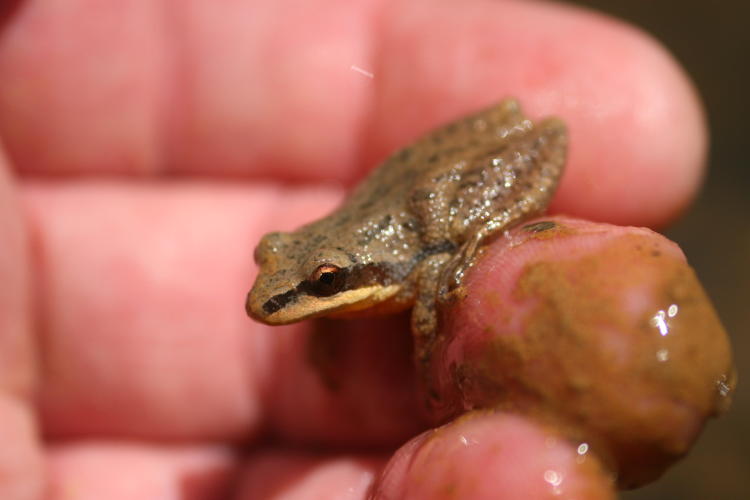
You want a better look at those eyes, don’t you? Of course you do.
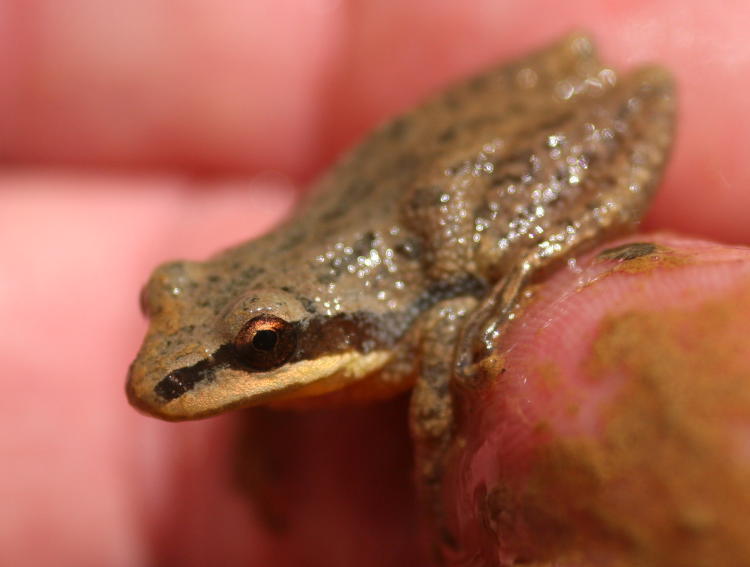
Notice how that dark band is semi-replicated right through the eye. Presumably this contrast marking accomplishes something, though to me it just made them easier to spot.
Leaving that little pool, we returned to the river’s edge with just a few more minutes before we had to head back, and I announced that we’d try to add another water snake to our tally for the day. This took all of three minutes, I believe.

Another northern water snake, this one was easily twice the mass of the previous finds, and I could see through the viewfinder that the eyes seemed to be either muddy or clouded, perhaps both. I surmise that it had just freed itself from the winter’s mud, but it could also have been approaching a molt, which causes the eyes to cloud up a bit. This one was almost certainly fast asleep, because it didn’t twitch in the slightest even though I approached to within a meter – much closer than the other snakes of the day that beat a hasty retreat. Come to think of it, maybe snakes can’t “beat a retreat” – you need feets for that. I’ll have to look it up.
Our attention to this one was noticed by some passing hikers, who got to hear me mouth off about the species before one of them pointed out another snake that was just a couple meters away in plain site atop some moss, one that we’d both missed. This one was another queen snake (Regina septemvittata,) coiled smartly and also not twitching.

I included this image because I like how the light brought out the textures of those scales, but it’s ridiculously deceptive – this one was many times smaller than the northern water snake preceding it, only about as big around as my little finger at most. Snakes don’t have eyelids so you can’t tell when they’re asleep except for their lack of response to a close approach, but if you throw your shadow over them they’ll take off in a flash. This one didn’t move until I had actually grasped it, and unlike the other named species, queen snakes aren’t in the least aggressive, so all it did was struggle in a very half-hearted way, and I soon released it after a few pics; getting ahold of it was partly to confirm that it really had been asleep, and partly to demonstrate how harmless most snakes are.
And finally, I close with a non-herp image, one of the many small wildflowers that were making their first appearance throughout the park. This is a Virginia spring beauty (Claytonia virginica,) which along with some winter speedwell and trout lilies were the first bits of color to appear – well, let’s not dismiss the daffodils, but seriously, they don’t count. Don’t ask me what a Virginia flower is doing way down here – probably just trying to get some greater distance from DC, and who can blame it?





















































